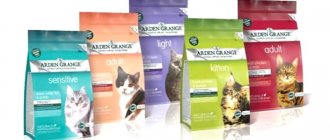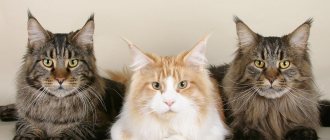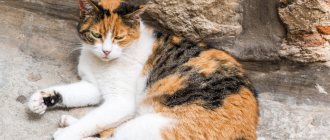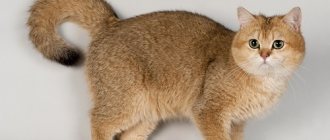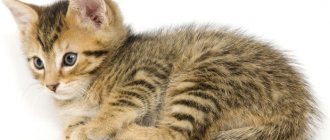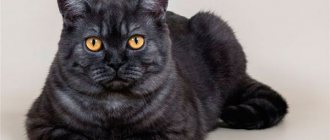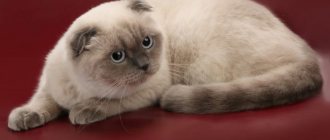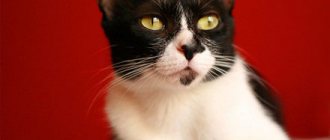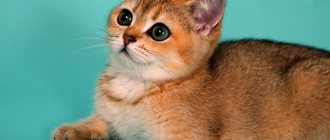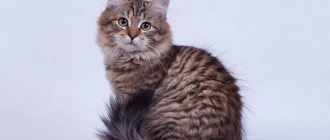join the discussion
Share with your friends
Scottish cats are charming pets with expressive eyes and plush fur. They are distinguished not only by their peaceful disposition, but also by their chic palette of colors. Perhaps one of the most unusual are Scottish golden cats. This shade of wool belongs to the “shaded” colors and attracts the attention of breeders around the world.
About the breed
Based on the name, this breed first appeared in Scotland. However, some researchers claim that similar cats lived in eastern countries several hundred years ago. Fluffy cats look very much like British Shorthairs.
By the way, they are considered close relatives and have many similar features.
The characteristics of the breed include the following.
- Strong muscular body of correct proportions.
- Small head with a round muzzle. Outwardly, the Scot resembles a teddy bear.
- Short well developed neck.
- Massive limbs with soft paw pads.
- Expressive eyes. In most cases, this breed has orange eyes, but there are blue-eyed and green-eyed individuals.
- The Scottish coat is soft (plush) and shiny. The fur fits tightly to the body. There are short-haired and long-haired varieties of the breed.
- Adult cats weigh no more than 6 kg. Small kittens are especially adorable and resemble a soft toy.
The main feature of the breed is the shape of the ears. The fact is that Scottish cats are divided into several types: Scottish Fold and Straight (short-haired) and Highland Fold and Straight (long-haired). Straight cats have straight ears, while animals called fold have fold ears.
Types of British chinchillas
According to the breed standard, pets' fur should be shiny and elastic. Very soft or too close-fitting fur is considered a fault. Depending on the length of the coat, the following types of chinchilla cats are distinguished:
- short-haired;
- long-haired;
- lop-eared
Shorthair
The representative of the species has a short type of coat with a dense, thick undercoat. The chinchilla cat has all the characteristics of a British Shorthair.
Longhair
Not all felinological organizations and clubs recognize the British with long fur. Some breeders express the opinion that it is undesirable to separate these individuals into a separate species. Since the experts sought precisely to breed “beaver” fur, springy, plush.
The British long-haired chinchilla cat got the size of its fur from mating with Persians. Such experiments were abandoned to preserve the purity of the breed, but the distinctive gene remained. You should not be surprised if, as a result of crossing two short-haired cats, a long-haired pet is born.
Fold
At the age of 20-23 days, the ears of the babies are not formed, but closer to 1 month of life it is clearly visible whether they are pressed to the head or not. The British received drooping ear tassels from Scottish descendants. There is an opinion that there are no lop-eared Britons.
Features of color
Cute and miniature pets amaze with the variety of their colors. They can be divided into the following groups.
- Plain or solid. The fur of cats is painted in one color.
- Tabby. Animal fur has a patterned color.
- Color point. White cats with blue eyes.
- Tortoiseshells. The cats' fur is "decorated" with spots of dark colors.
- Shaded . Real “jewels” among cats.
The golden color of the Scots is a unique phenomenon that attracts the attention of all avid “cat lovers”. It is classified as shaded colors. These cats have a light peach undercoat, and the fur has a beautiful golden color. The eyes are green, and the paw pads and nose are chocolate color.
Ticked cats also have a golden hue to their fur . This color is an alternation of dark and light stripes on each hair. The wool itself is cast in gold or silver. The eye color of babies is yellow, which also has a golden tint. Among the Scots, this color is rare, so ticked kittens command a high price.
Another variety of Scots has golden-colored fur. This color is called “marble on gold” . It is quite rare, so it is of great interest to breeders. The fur of these unusual pets is decorated with dark stripes in the form of geometric shapes. Golden merle cats have the letter “M” on their forehead. The animals' eyes are copper-colored.
Scottish cats with golden coat color are real “jewels” of the cat world.
BRITISH SHORTHAIR GOLDEN TABBY CAT: VARIETIES OF COLOR PATTERNS
British shorthair cat, golden tabby color, is divided into several subspecies:
| Ticked color | Marble color |
Spotted color | Striped color |
Tabby colors:
- British ticked (similar to a chinchilla, only darker on the back);
- British spotted (leopard);
- British tabby;
- British marble.
Care and maintenance
Before bringing a Scottish kitten home, the breeder must prepare for this event. A furry baby needs to purchase bedding made from natural materials, a small tray, a scratching post and toys in advance. Raising a kitten should be done from the first days of its arrival in the house. The Scots have a fairly easy-going disposition and are easy to “train.” They easily remember commands and respond to nicknames.
Caring for the six species, both short-haired and long-haired, requires special attention. Regular brushing and washing is the key to your pet's health. It is best to bathe the animal in warm water, at least once every 2 weeks. It is also important to keep your cats' eyes and ears clean. For the eyes, special drops purchased at a pet store are suitable. And for the hygiene of pets' ears, cotton swabs are used.
Scottish cats can be fed with natural and industrial food. For example, lean meat, cereals, fish products and boiled vegetables are perfect. As for “purchased” food, it is better for Scots breeders to choose premium products. They do not contain harmful substances and are well absorbed.
Babies are fed up to 6 times a day, and an adult cat only needs to eat 2 times a day. It is no coincidence that Scottish cats are compared to a plush toy. They are very friendly and love to play with small family members. They do not show aggression towards other animals in the house and can spend hours with their favorite toy.
Features of care
Despite its “royal coat,” the animal is not adapted to low temperatures. A comfortable temperature for him is above 20 degrees Celsius.
Hygiene
Caring for a golden Scottish chinchilla involves several procedures, but the main thing is coat care:
- once a week comb out with a special brush in two directions;
- after combing, collect hairs with a damp hand;
- during the molting period, comb out daily.
Cats do not like bathing, but once every six months they need to do water treatments with a special shampoo.
Process as needed:
- ears - clean out accumulated dirt with a swab moistened with petroleum jelly;
- eyes - wipe with tea leaves, chamomile infusion;
- nose - remove discharge with a napkin;
- teeth - brushed daily with a special soft-bristle brush or a cat brush placed on your finger;
- claws - as they grow, remove them with a nail clipper.
Periodically take the chinchilla for a walk, before putting on a flea collar.
The cat is exceptionally clean and loves hygiene, so the litter box must be kept clean.
Nutrition
Golden Scottish chinchillas have a good appetite and gain weight easily, so the cat’s diet needs to be adjusted.
It is better to feed the animal with premium balanced dry food. It contains the entire complex of vitamins and microelements necessary for the body.
When feeding with natural products, the diet includes:
- boiled chicken, turkey, veal, rabbit, offal;
- boiled sea fish fillet;
- fermented milk products, eggs;
- vegetables, boiled cereals;
- sprouted grains;
- complex of vitamins.
Regardless of what diet you choose, make sure that the kitten drinks a lot of clean water.
Solid (solid, plain)
A solid color implies the absence of any slightest admixture of other shades. The surface of the fur is colored evenly on all parts of the body. The Scots once upon a time considered gray or blue to be the most common color. These are the favorites most often found among breeders. But today seals with other colors are also gaining more and more popularity: white, chocolate, black, brown, cream, red and fawn (which literally means the color of a young deer). Sometimes it happens that nature interferes with the uniform color of the fur and leaves a mark of a different color there. Such cats noticeably lose value because they are considered a breed defect.
Point (point)
The more common name for this color is color point. It is characterized by the fact that the main color of the animal turns into a darker color at the tip of the muzzle, tail, ears and paws. This is due to the fact that in the blood of such animals there is a special gene that affects the darkening of the hair in those parts of the body where the temperature is low.
There are several variations of this color, which are shown in the table below, there may be others:
| Color name, photo | Main color | Additional color |
| Seal Point | Light beige | Brown |
| Lilac Point | White | Lilac |
| Blue Point | Pale blue | Dark blue |
| Chalklit Point | White | Brown |
| Cream-point Cream-blue-point | Pale cream | Cream |
| Red point | Pale cream | Ginger |
| Tabby (lynx) point | Any | Stripes to match the main color |
| Torty point | Tortoiseshell | Red or cream spots on the base coat color |
Torti (turtle)
It should be noted right away that you can only buy a turtle girl. In males, this color is not provided by genetics. But if you do come across a cat like this, then this is a big exception, which, however, does not increase its cost, but, on the contrary, reduces it.
Tortoiseshell color is considered to be fur on which spots of different colors (black, chocolate, blue, lilac) alternate with red or cream marks. For breeders, a particularly important indicator is the intensity of pigment expression and uniformity of location.
SHADED BLACK GOLDEN BRITISH: PHOTO GALLERY
British - golden black shaded color - see photo gallery. Pictured here are British golden kittens, as well as adult British cats and female cats.
| In our cattery you can “buy a real British kitten.” We have many different colors, we will help you choose and answer all your questions! |
Smoky (smoky, smoky)
The main condition for this color is that the hairs at the base of the body must have a silver-white tint. Those. the silvery-white hair turns into another color, such as black or blue. This phenomenon is called typing and occurs as a result of a dominant silver gene. The smoke can be different, for example, chocolate.
There are often cats with additional patterns on their fur, but according to color rules this should not be the case.
Don't confuse this color with a solid color! If you're not sure, part your cat's fur and see what color is at the base of his fur.
Social structure and reproduction
Photo: British Golden Chinchilla kitten
It is recommended to breed animals by professionals who have experience in this field. The British Golden Chinchilla is bred mainly in specialized nurseries. Before breeding cats at home, you should study the intricacies of this matter. Zoologists warn that this breed is not fully formed. During mating and pregnancy, cats need special care and attention. The first step is to take care of choosing suitable partners for breeding.
Criteria for selecting partners:
- the presence of all the characteristics characteristic of this breed in candidates for mating;
- absence of diseases and hereditary pathologies;
- healthy appearance;
- activity;
- availability of all necessary documentation;
- availability of a vaccination passport and all vaccinations in it.
Golden chinchillas are characterized by late development. It is recommended to get them at a time when they become independent, can go to the toilet on their own and eat adult food.
Tabby (tabby)
Such cats have stripes of an unusual shape and a different color than the main color. The most common marks are on the forehead, for example, in the shape of the letter M, light spots on the back of the ears, a necklace on the chest, rings on the paws and tail, curls on the cheeks, eyes outlined as if with shadows.
Breeders distinguish several variants of tabby. According to the type of pattern, they are marbled (shaded), tiger (mackerel) and spotted (spotted).
There is a complex classification of Scots tabby dogs based on combined colors and shades. They are presented in the table below:
| Name | Main color | Pattern color |
| Silver | Silver | Black |
| Silver blue | Light blue, white undercoat | Mantle on muzzle, tail and sides |
| Red | Light red | Bright red |
| Brown | Copper | Black |
| Blue | Cream blue | Bright blue |
| Cream | Pale cream | Beige or dark cream |
| Cameo | White | Bright red |
Shedded (shaded)
With this type of color, two-thirds of the hair starting from the base is white, and the remaining part can be red, silver or gold. On the chin, belly and lower surface of the tail the color is light. The shaded color does not allow spots or stripes except those located on the forehead or paws.
Representatives of the Scottish breed with a similar color have white coat color as the main color, and the tail and muzzle are decorated with a different color or a combination of both (torti). There may also be spots on the body and paws.
Description of the breed (requirements for the standard)
British and Scottish cats have round, soft shapes and limbs that are proportional and harmonious. The compactness and roundness is achieved not only due to the thick coat, but also because representatives of the breed have very developed muscles. The front and hind legs are the same length, the tail has a slightly rounded tip.
The head is small but massive, with a well-defined chin. There is always a small plane on the forehead, however, if you look in profile, there will be a noticeable depression between the nose and forehead.
The ears of a chinchilla cat are wide and small, and the fur covers the back of them with a uniform, dense carpet. Huge eyes are set wide and very expressive, green in color (less often golden).
The rarest colors of Scottish cats
Several years ago, the highest price was set for kittens of unusual silver and gold shades. But in the modern cat market there are more and more of them. Today, ticked Scots and golden chinchillas are considered the most expensive.
Scottish straight golden chinchilla
Interesting! The most common iris color among Scots is gold. However, there are some exceptions. Usually the eye color matches the coat. Blue or multi-colored eyes are quite rare, these animals can be white, bicolor or tortie. Orange iris is a very beautiful, but the rarest eye color in this breed.
Description
British Golden Chinchillas tend to be soft and round in shape. The fur of representatives of this breed is very matted and thick, and the undercoat is also printed. The fur is so soft that it resembles an arctic fox.
British chinchillas boast well-developed muscles; their front and rear legs sometimes look shorter than they actually are.
The tail of golden chinchillas is large, thick and fluffy, the hair on it is longer than on the entire body.
The head and ears are small. The ears are slightly sloping and are located at a sufficient distance from each other. The eyes are large.
The coat of golden chinchillas is only partially colored. The undercoat usually has a cream, apricot or milky color, and the coat itself is gray-red, that is, each tip is only slightly painted in a dark color, which creates such an amazing shade of playing gold on the fur coat.
A distinctive feature of golden chinchillas is the eyeliner around the eyes and nose that is dark brown, almost black.
Adult cats can gain weight up to 8 kg, while cats weigh up to 4-5 kg. It is also worth noting that spayed and neutered animals can weigh up to 10 kg.
Genetics of Scottish cat colors
In cats of this breed, 2 genes predominate, which are responsible for the red and black color. One of them acts as dominant, and the other as recessive (i.e., the one that is suppressed). There is also a 3 diluent gene, which is responsible for the saturation of the pigment. These genes are combined and as a result we get a variety of colors: from the well-known blue to the cheerful-looking harlequin.
By the way, while the kitten is still small (several weeks), it is impossible to say exactly what its color will be. The final coloring is formed when, after a child's molt, the coat is replaced by an adult coat. Usually the color is ready by six months, although it may change slightly for another 1.5 years.
SHADED BRITISH GOLDEN KITTENS
Shaded British Golden kittens are very rare, especially if they are of good British type. Now many breeders, in pursuit of novelty in color and exclusivity, are working on breeding such rare colors of animals.
The Shaded British Golden kitten can only be born to golden parents, or to a silver with green (and only green) eyes who have the gold gene in their pedigree. Such golden British kittens are not cheap, but the price is justified, since it is an incomparable feeling of pride for your magnificent animal in such a rare color.
Scottish cat color charts
When purchasing a Scottish kitten with a passport from a breeder, most likely you will see markings of numbers and letters there. This is an international code used in the classification accepted among breeders. The Scottish breed includes four cats: fold-eared (Scottish Fold), straight-eared (Scottish Straight), long-haired fold-eared (Highland Fold), straight-eared long-haired (Highland Straight).
This is what the color code looks like: XXX.xx.NN.NN.NN.(NN) , where:
XXX . Abbreviated name of the breed in three capital letters: SFS - Scottish Fold, SFS 71* - Scottish Straight, SFL - Highland Fold, SFL 71* - Highland Straight.
xx . Lowercase letters indicating the main coat color (up to two):
| Letter (designation) | English name | Russian name |
| a | blue | blue |
| b | chocolate, brown, chestnut | chocolate, brown, Havana, champagne |
| c | lilac, lavender | lilac, lavender, platinum |
| d | red, flame | red |
| e | cream | cream |
| f | tortoiseshell, patch | tortoiseshell |
| g | blue-cream, blue-tortie | blue cream, blue tortoiseshell |
| h | chocolate-tortie | chocolate tortoiseshell |
| j | lilac-tortie | lilac tortoiseshell |
| n | black, ebony, seal, sable, ruddy | black, ebony, seal, sable, wild |
| o | sorrel, cinnamon, honey | sorrel, cinnamon, honey |
| p | beige fawn | yellow-brown, beige |
| q | sorrel tortie | red-brown tortoiseshell |
| r | beige fawn cake | beige tortoiseshell |
| s | silver, smoke | silver, smoky |
| w | white | white |
| y | golden | golden |
| z | unregistered | unregistered |
NN.NN.NN.(NN) - values of pairs of digits (up to 3 main and 1 auxiliary):
- Numbers from 1 to 35, which decipher the color features (harlequin, van, smoke, etc.):
| Letter (designation) | English name | Russian name |
| 01 | van | van |
| 02 | harlequin | harlequin |
| 03 | bicolour | two-color, bicolor |
| 04 | mitted/white point | with white markings (for color points) |
| 09 | little white spots | white spotting (1-2 cm) |
| 11 | shaded | shaded (1/4 of the top part of the hair is darkened) |
| 12 | tipped, shell | veiled (1/8 of the top part of the hair is darkened) |
| 21 | tabby, agouti | striping, agouti factor |
| 22 | blotched, marble | marble |
| 23 | mackerel, tiger | mackerel, tiger |
| 24 | spotted | spotted |
| 25 | ticked | ticked or Abyssinian |
| 31 | burmese | Burmese |
| 32 | tonkinese | Tonkinese |
| 33 | himalayan or siam | Himalayan, Siamese, point |
| 34 | Singapore | Singaporean |
| 35 | abyssinian | Abyssinian |
- A pair of numbers from 51 to 54 indicating the length of the tail:
| Letter (designation) | English name | Russian name |
| 51 | rumpy | taillessness |
| 52 | rumpy riser | remainder of the tail – 1-2 vertebrae |
| 53 | stumpy | bob – 7-13 cm. curled tail |
| 54 | longy | long/normal tail |
- A pair of numbers from 61 to 67 indicating eye color:
| Letter (designation) | English name | Russian name |
| 61 | blue | blue |
| 62 | yellow, golden | yellow, orange, golden |
| 63 | oddeyed | disagreement |
| 64 | green | green |
| 65 | burmese | Burmese cat eye color |
| 66 | onkinese | Tonkinese cat eye color |
| 67 | himalayan or siam | eye color of Himalayan and Siamese cats |
- A pair of numbers 71 (straight) or 73 (dropping), indicating the shape of the ears.
How coat color affects the character of a Scotsman
When purchasing a pet, you should not chase fashion; it is better to trust your preferences and tastes. The main thing is that the cat turns out to be “yours” in temperament and character. By the way, some cat owners are sure that the color of the fur affects the behavior of the animal and leaves an imprint on its character.
White and light colored
You want to cuddle these babies endlessly. But they, as a rule, do not like increased attention to themselves. Although they are very loyal to the owner, they are extremely wary and wary of other people. Among some peoples there is a belief that a white cat brings good luck. Whether this is true or not is not known for certain. But the white color can cause a lot of problems for the cats themselves, since 5% of all snow-white cats are born completely deaf. Previously, it was believed that deafness was the fate of absolutely all white-furred tails, but later scientists proved that this is not so. But when buying such a kitten, you should still be more careful.
Black
Despite all the existing prejudices and myths regarding black cats, in practice they are one of the friendliest towards people. They like to stay close to their owner all their free time and always keep him in sight. Charcoal cats are wise, quick-witted, and keenly aware of a person’s mood.
Redheads
Such animals are a ray of sunshine in your home. It is believed that a ginger cat in the home is the key to an indispensable increase in well-being. Those with fiery fur are very playful, willful, cheerful and curious creatures. The golden shades of fur that are fashionable today are characteristic of more formidable animals, whose disposition can hardly be called friendly. And golden Siamese cats are generally considered the worst tailed cats.
Blue and silver
Silver and blue fluffies are real aristocrats. Calm, balanced, noble. They love their owner devotedly, although they are not always ready to demonstrate this publicly. It is believed that these four-legged pets are able to calm and relieve stress in humans. In addition, cats of this color are absolutely not vindictive.
Two-color
Such cats are most in demand among buyers. In addition to their interesting color, they have an easy-going disposition, are friendly, and kind even towards children. Bicolor cats love their owners very much and get along well with other pets.
Features of the breed and character of the golden chinchilla cat
The British Golden Chinchilla appeared in Great Britain as a result of crossing other cat breeds that had the desired qualities for the result. And fluffy Persian cats and smooth-haired gray British cats acted as producers, so the resulting look has very thick gray fur of medium length.
Initially, chinchillas were only gray, but breeders did not stop there and began breeding golden coat color. The red color gene was present in cats due to the presence of red Persians in matings; it was only necessary to fix it.
The golden chinchilla is a cat that has inherited from its ancestors not only gorgeous appearance, but also a noble character, in which pride is perfectly combined with tenderness and meekness.
A distinctive and unusual feature is the animal's fur. It would seem that the uniform golden color throughout the cat’s body, upon closer examination, does not seem so monotonous.
All hairs of a purebred chinchilla have a pronounced gradient - a smooth transition from a soft peach color at the base to the black tips of the hairs. Thus, the color of the golden chinchilla has a slight black shade, which is especially pronounced on the back and sides of the cat.
Golden Britons become true friends for all family members. The aristocratic nature does not allow animals to forget about the rules of etiquette - always go to the toilet in the tray, eat in the kitchen, do not scratch the furniture, do not bother the owner with loud meows.
If there are small children living in a family with a golden chinchilla, there is no need to be afraid of aggression on its part, even if the children do not yet understand that it is forbidden to pull a cat’s whiskers or tail. Representatives of the breed have a flexible mind and understand that it is impossible to be aggressive towards cubs, even if they are not cats, but human ones.
However, golden chinchilla cats, with all their love for their owner and his family, are jealous of their own territory and personal space. So, if the cat does not want to “hugg” at the moment and makes it clear to the owner, it is better to give her time to mind her own, cat’s, affairs. For example, washing, sleeping or hunting your own tail.

